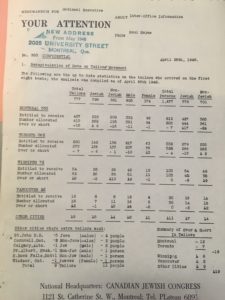Back in the day when Canada’s immigration policy was reflected in the phrase, “none is too many,” thousands of Jews languished in displaced persons (DP) camps throughout Europe.
For Max Enkin, it was an intolerable situation. As a businessman living in post-war Toronto, he was determined to bring Jewish refugees to Canada.
At the time, Canada faced a shortage of labour in a variety of fields. A policy had been implemented to attract loggers to the country, and the Canadian Jewish Congress had used its influence to include Jewish displaced persons in the mix.
Why not do the same for tailors, Enkin reasoned, setting in motion what would become known as the Tailor Project.
READ: THE FIRST JEWS IN CANADA
Beginning in 1948 and lasting for several years, the Tailor Project managed to bring 2,000 labourers into the country, to work in the rapidly growing needle trades. Half of them were Jews who were plucked from European DP camps.
Most settled in Montreal, Toronto and Winnipeg, and even though a good number weren’t really tailors – all they had to do was sew a button to be accepted – they began new lives in their new homes.
Now, Larry Enkin, Max Enkin’s son, wants to find out what happened to those immigrant tailors. With the assistance of Paul Klein – the founder and CEO of Impakt, an agency that helps companies benefit from social change – Enkin has begun a search to find the remaining tailors, along with their children and grandchildren. In January, he visited the Alex Dworkin Canadian Jewish Archives in Montreal and identified many of the families by checking ship manifests.
“They list the families’ names, professions and the fact that they were Jewish,” Klein said. “That’s a huge step forward.”

So far, they have compiled a list of between 500 and 600 names of people who they believe are some of the tailors who participated in the program, Klein added.
But it’s hard to track them down, so they are asking for the public’s help. They are planning to set up a website, where people will be able to log in and share their stories.
What will be done with that information is not totally clear at the moment, Enkin said. One thing they are looking at is something modeled after the Shoah Foundation, which interviews Holocaust survivors and documents their stories for posterity. Another option is to compile their histories in a book.
The idea is to document their “incredible contributions to Canada,” Klein said.
In addition, there might be some lessons that can be learned from the Jewish tailors’ experiences that might be applicable to immigrants today, he suggested.
Anne Dublin thinks her father may have been one of the Jewish tailors who immigrated to Canada as part of the program, but she’s not sure.
During his life, they never really talked about how he came to Canada, she said.

However, her father, Morris Dublin, fit the criteria that was used at the time. Prior to the war, he grew up in the southeastern Polish town of Sosnowiec. After his bar mitzvah, he left school and became a tailor to help support his family.
After the Nazi invasion in September 1939, the town’s synagogue was burned down and German forces rounded up and shot some Jewish men, including his brother-in-law.
Sensing more trouble to come, his immediate family and close relatives fled to the Soviet Union, where they spent the war. Afterwards, they escaped, eventually finding their way to a DP camp in Riedenberg, near Salzburg, Austria. That’s where Anne Dublin and her twin brother, Max, were born, joining their sister, Helen, who was born in the Soviet Union.
In 1948, the family boarded a ship and sailed for Canada. Upon their arrival, Morris Dublin got a job as a tailor, working for Lloyd’s Brothers, a well-known men’s shop at the time. After a decade or so, he left to start his own dry cleaning business.
Anne Dublin went on to become an author of children’s books.
Dublin’s is the kind of story that Enkin is looking to document. As a boy, he remembers the first tailors arriving in Toronto, and how their employers in the garment industry advanced them each $25 to help get them started.
It’s not a part of Canada’s Jewish history that is so well known. “We want to do something that will enable the Jewish community to have a full record of what went on,” Larry Enkin said.






![Irving Abella speaks at the launch of Jewish Heritage Month. [Leigh Brown photo]](https://thecjn.ca/wp-content/uploads/2013/05/abella-300x161.jpg)